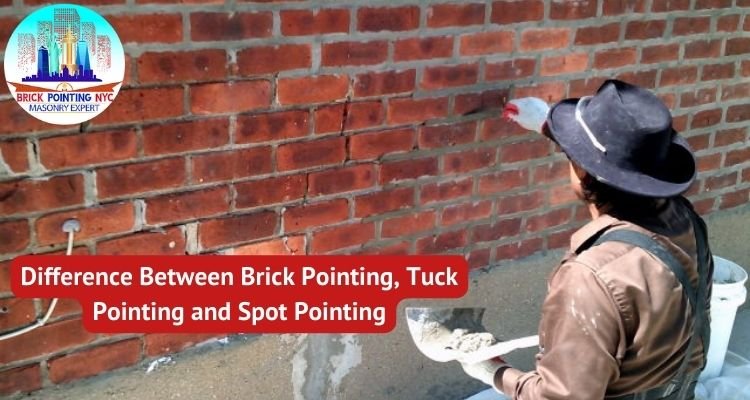Brick, like any other durable material, requires periodic upkeep. When the efflorescence on a brick surface becomes unsightly, it is time to reapply the water sealant. Bricks that have been damaged must be fixed or replaced.
Tuckpointing, the restoration of mortar joints, is another crucial upkeep job. Inexpensive yet time-consuming, brick pointing cleans up mortar lines and retains the complete brick system.
Brick Pointing, Tuckpointing, And Spot Pointing: What’s The Difference?
Brick Pointing
Because it supports the structure’s load, brick pointing is essential to building maintenance for commercial and residential buildings. Bricks with uneven or cracked mortar may hold too much weight since it is difficult for the cannon to distribute the load evenly.
Poor brick pointing may also let in water, which might cause problems. Much water damage is undetectable until it is too late to repair or replace, increasing repair or replacement costs.
Tuckpointing
To fix the mortar between the bricks in your structure, a technique known as “tuckpointing” is used. Damage to mortar means it can no longer accomplish its vital duty of shifting weight and preserving the building’s structural integrity. Brick Pointing is rehabilitating and revitalizing your structure by removing the old mortar and replacing it with fresh material.
Spot Pointing
Spot tuckpointing is a kind of repointing that is performed on a more localized basis. It entails fixing the most noticeable openings and settling cracks in an otherwise sound structure. Simply put, we are repairing leaks to slow the rate of degradation. Spot pointing brick walls is an excellent method of repairing exterior wall damage, as could be expected. If something were to crash into the side of your house and knock a few bricks loose or leave a little dent in your wall, spot tuckpointing would help you restore its former splendor.
In addition, if a localized area of your home’s exterior is subjected to more severe weather conditions than the remainder of the structure, you may need to do some spot tuckpointing. Additionally, spot pointing may be used to clean up any faded or broken sections, which can be helpful for those who want to sell their property and enhance its appeal immediately.
Mortar Repair Warning Signs
As was said before, a brick building’s mortar joints might begin to deteriorate in as little as 20 to 30 years. Indicators that your mortar joints require fixing include,
- The mortar had eroded more than 6 millimetres.
- There are areas where the mortar has wholly crumbled away.
- The mortar has little fractures in it.
- There might be crevices or spaces before the mortar even reaches the bricks.
Time for Repointing
Examine the structure to see whether it needs cleaning before repointing brick wall. When there is soiling, lichen, moss, ivy, and the like, cleaning before repointing ensures that all damage is visible. This ensures the fresh mortar is applied on a stable, dirt-free surface. After the repointing is done, a minor cleaning may be necessary to get rid of mortar stains.
The amount of failing joints should be considered when selecting whether to do a partial or complete brickwork pointing. Ten per cent to fifty per cent of joint deterioration calls for repointing. If there is more than that, it has to be brick pointing entirely.
It is probably time to repoint the whole structure if different mortar colours are present. Getting an accurate building survey is challenging; following this advice will help ensure that bids are comparable and change orders are minimal. In addition, whether you are doing a partial or complete repoint, the expense of gaining access to the area (through scaffolding, a swing stage, or a man lift) will be substantial. Check out the brick pointing cost.
The Action of Replacing Old Stones
Repointing replaces old, crumbling mortar in a joint with fresh, structurally sound mortar. The cleaned-out, squared-off cut joint must be devoid of dust and unsound mortar and not have a V or U shape. Dust may be washed away by rinsing the cracks. Create a sand-cement-water paste that resembles peanut butter. Accurate measurement of amounts is essential for achieving a uniform look. Then, a mechanical mixer is required for the best results.
Once the joint is moist but not wet, the mortar should be crushed into it in 1/4-inch thicknesses, or “lifts.” Keep the mortar in the joint to prevent it from dripping or leaving streaks on the brickwork materials. Once the mortar is “thumbprint hard,” the connection may be a tool to fit the present contour. Prevent the mortar from drying out too much. When brick tuckpointing older structures, it is essential to keep mortar shrinkage minimal. Ensuring the aggregates are suitably graded, with the largest grains making up no more than 30% of the mortar joint, is part of the strategy. Shrinkage fractures may be avoided by hydrating a firm mortar every 3-6 hours for many days after installation.
Which One Should I Choose?
Look no farther than the surface to determine if your wall or structure needs Spot or solid tuckpointing. Spot pointing is acceptable if damage accounts for less than 10% of the total area. But if it’s any more significant than that, sturdy tuckpointing will be required. If you feel you need pinpointing, you should survey the whole vicinity. Continuing with a more substantial scale, solid tuckpointing may be more cost-effective if the surrounding brick-and-mortar has almost eroded. If you do not, there is a considerable risk you’ll mix fresh mortar with artillery on the verge of failing. This would not be good for the building as a whole, and it would eventually need to be tuckpointed. Spot pointing is also not as effective as fixing the whole wall or building, especially if the surrounding region already shows signs of age. Remember that Spot pointing works best on buildings with recent, high-quality tuckpointing within the preceding 10–15 years.
It is essential to address the problem immediately, whether it requires Spot pointing or full tuckpointing. Pointing brick walls is a labor-intensive task. Thus, the associated expenses should reflect the estimated time spent doing the work. Therefore, start with the worst parts and go to the rest of the house. If the job is minor, doing all the necessary repairs at once is more efficient.
Remember that brick buildings need frequent inspection for severe damage and wear and tear. After severe storms, localized damage often happens when trees or other heavy items crash through non-functioning gutters or other spots where water pools quickly or when severe domestic mishaps occur. Even if the damage seems to be contained in one area, it is always a good idea to have professional brick pointing contractors look just to be safe.
Conclusion
Spot pointing and masonry repointing are two distinct but related types of work. Both may be used in place of mortar to repair holes and cracks in a brick wall. On the other hand, tuckpointing is used to enhance structural integrity and for aesthetic purposes, whereas repointing is exclusively employed for preserving the strength of the structure. Before hiring a professional check out the tuck point brick cost.


